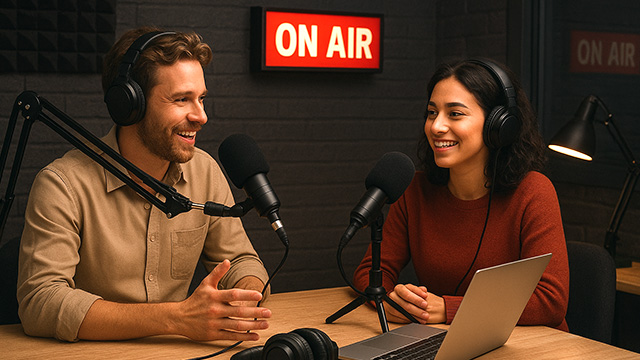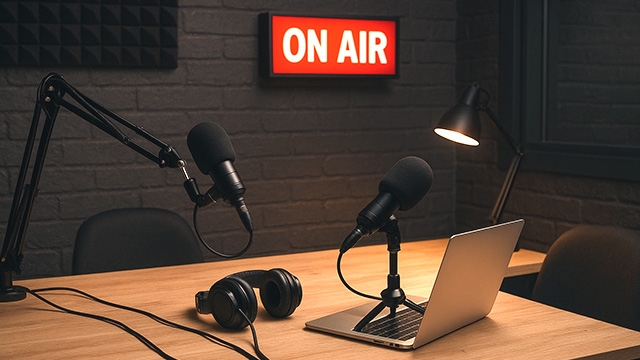Why Podcasts Have Become the Media Form of the Decade and How They Are Produced with Modern Equipment
Yes! The golden age has arrived, when each of us, through our smartphone or smart TV, can create our own television and, of course, radio! Over the past ten years, podcasts have evolved from a niche entertainment for enthusiasts into one of the most powerful media formats. Millions of people around the world listen daily to stories, interviews, educational programs, and audio series on their phones, in their cars, or at home. In this article, we will explore why podcasts have become a modern phenomenon and how high-quality content is created using contemporary equipment.
Why Podcasts Have Captured an Audience
Convenience and Accessibility
One of the main factors behind the popularity of podcasts is their accessibility. Listeners can tune in at any time: during their commute, workouts, or household chores. The “audio-on-the-go” format perfectly fits the modern pace of life, where people do not always have time to read or watch videos.
Personalization of Content
Podcasts allow listeners to choose topics that interest them, from finance and technology to psychology and pop culture. Platforms enable subscriptions to specific shows, creating a personalized media library. As a result, podcasts become not just entertainment but a source of knowledge and inspiration.
Depth and Intimacy
Audio allows for a deeper immersion into a topic. Unlike fast-paced video content, podcasts give hosts and guests the space to fully elaborate on their thoughts. The voice creates a sense of personal connection, making the content feel intimate and trustworthy. This is exactly what attracts an audience seeking quality and thoughtful material.
Low Barrier to Entry
Creating a podcast has become easier than producing a video blog or a print publication. To start, all you need is an idea, a microphone, and a computer with recording software. This opens doors for new creators, startups, and experts who want to share their experience without large production budgets.
How Podcasts Are Produced with Modern Equipment
Producing a podcast today combines creativity and technology. Let’s look at the stages and equipment professionals use.
Preparation and Script
Before turning on the microphone, it is important to plan the show’s concept and create a script or conversation outline. For large projects, this may involve detailed storyboards of episodes; for conversational podcasts, a list of key questions may suffice.
Observing the market, more and more brands and creators want to enter this format. If you are a media content producer, it is important not only to understand why the audio format has become the leading media of the last decade but also to know what equipment and software to use at different production levels. So:
1. Beginner Level: Starting Without Large Investments
If you are just starting, you do not need a professional studio setup. A minimal kit is sufficient:
- Microphone: USB microphones like Blue Yeti, Rode NT-USB, or Samson Q2U provide acceptable quality without an audio interface.
- Headphones: Any closed-back monitoring headphones, such as Audio-Technica ATH-M20x.
- Software: Free programs like Audacity or Ocenaudio allow recording, noise removal, and track mixing.
- Remote Interviews: Zoom, Skype, or free versions of Zencastr can be used, but quality will depend on the internet connection.
At this level, it is important to ensure a quiet room and proper microphone placement to achieve clean audio.
2. Intermediate Level: For Regular Podcasts and a Small Audience
For creators releasing episodes regularly and seeking more professional sound:
- Microphones: Shure SM7B, Rode Procaster, Heil PR-40 — offer rich and “dense” sound.
- Audio Interfaces: Focusrite Scarlett 2i2, PreSonus Studio 24c — provide high-quality microphone connection and signal level control.
- Software: Adobe Audition, Reaper, Hindenburg Journalist — allow more complex editing, voice processing, and mixing with music and effects.
- Remote Interviews: Professional platforms like Riverside.fm or SquadCast record high-quality sound on both ends.
At this level, controlling room acoustics is crucial: sound absorbers, foam panels, or even simple fabric can significantly improve audio quality.
3. Professional Level: Studio Quality and Large Projects
For major media projects and commercial podcasts:
- Microphones: Top studio models, including Neumann TLM 103, Sennheiser MKH 416, or Electro-Voice RE20.
- Audio Interfaces and Mixers: Universal Audio Apollo Twin, RME Babyface, Behringer X32 — provide precise sound control and allow immediate addition of effects.
- Software: Advanced DAWs (Digital Audio Workstations) like Pro Tools, Ableton Live, Logic Pro X for complex editing, mixing, and mastering.
- Studio Conditions: Recording booths, professional acoustic treatment, use of noise gates, compressors, and equalizers.
- Remote Recordings: Studio services with high bandwidth and uncompressed recording (WAV, 48 kHz, 24 bit).
At the professional level, attention to detail, high-quality sound, and effective content delivery become the main competitive advantages. Our team is ready to assist you in achieving this.
4. Additional Elements for a Quality Podcast
- Music and Sound Effects: Paid or free music libraries (Epidemic Sound, Artlist, Free Music Archive).
- Editing and Storytelling: Thoughtful scripting, timing, and episode structuring — tasks easily handled by AI or our copywriter.
- Distribution and Analytics: Platforms like Anchor, Podbean, Libsyn, Yandex, BK allow publishing and promotion, with analytics showing the most popular episodes and listener drop-off points.
Analytics and Audience Engagement
Modern platforms provide detailed statistics: how many people are listening, at which points they stop, and which episodes are most popular. This helps creators improve content and build growth strategies.
Podcasts are a media platform that combines convenience, depth, and personalization. Their popularity is driven not only by the format but also by technological progress: modern equipment and software allow even small teams to create high-quality audio. For media content producers, podcasts open new opportunities, from audience engagement to monetization and brand expansion.
In the coming years, podcasts will only gain momentum, becoming a full-fledged tool for marketing, education, and entertainment. Understanding how they are created and using modern technologies is key to success in the marketing world. Interested in exploring this? Our team can help you record a podcast or stream — audio or video — at the highest quality. We have a studio and all the necessary equipment. Call us!